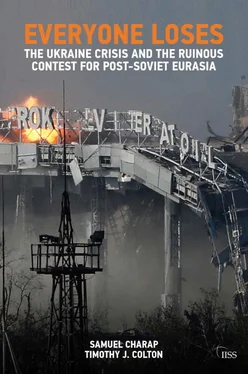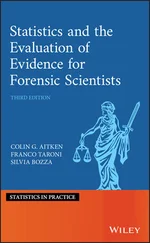The current chapter tells the tale of the Cold Peace, in Boris Yeltsin’s evocative phrase. It is bookended by the implosion of the Soviet Union’s zone of external hegemony at the end of the 1980s, which, despite the giddiness of the moment, left some bedrock issues unresolved, and a natural inflection point in 2003–04, the highlight of which was the ‘colour revolutions’ that tore through several post-Soviet states. Later chapters will deal with the more conflictual periods to come.
The settlement-that-wasn’t
The Cold War between West and East, centred on if not confined to Europe, came undone with amazing swiftness. The outcome, while an undeniable advancement on the way things were, fell short of the promise of a continent united and democratically governed, as many had hoped. We are still living with the consequences of the unfinished business.
Europe had been cleaved for decades along geopolitical, geo-economic and geo-ideational lines. It hosted two bristling military alliances (NATO to defend Western Europe and North America, and the Warsaw Pact for the Soviet Union and its six-country bloc in East Central Europe); two economic unions (the European Community, or EC, and the Council for Mutual Economic Assistance, or COMECON); and two ideological camps (espousing liberal democracy in the west, and collectivist autocracy in the east). The Berlin Wall, replete with barbed wire, watchtowers and minefields, epitomised the continent’s disunion.
Seismic changes originated with Mikhail Gorbachev, the general secretary appointed by the Soviet ‘selectorate’ in 1985. Gorbachevian perestroika was about ‘new thinking’ in foreign policy as well as remaking the Soviet Union’s hidebound internal systems. He began a loosening of the ties that bound the USSR’s European vassals – Poland, East Germany (also known as the German Democratic Republic, or GDR), Czechoslovakia, Hungary, Romania and Bulgaria – to Moscow, and nudged them to mount their own perestroikas. Gorbachev’s acknowledgement in March 1988 that all socialist countries had ‘the inalienable right to decide independently their developmental path’ signified the repeal of the ‘Brezhnev Doctrine’ of using all means necessary, including armed intervention, to prevent defection from the bloc.
The Kremlin originally intended for change in its camp to be evolutionary; inadvertently, it opened the floodgates to revolutionary change. Marxist-Leninist governments fell one by one in a tumultuous six-month stretch in 1989, commencing with the electoral victory of the Solidarity labour movement in Poland in June and closing in December with the execution by firing squad of Romanian dictator Nicolae Ceauşescu. The Berlin Wall was sundered on 9 November and chunks of it carted off by jubilant spectators as souvenirs. In 1990 and 1991 came the reunification of Germany (and ipso facto the disappearance of the GDR), the self-liquidation of the Warsaw Pact and COMECON, and, most remarkable of all, the dismantlement of the Soviet Union and of the Soviet political-economic system. As the newly minted president of Czechoslovakia, the playwright and ex-dissident Václav Havel, was to tell the US Congress in February 1990, new developments were coming on at such a clip that ‘none of the familiar political speedometers is adequate’. [3] ‘Text of Havel’s Speech to Congress’, 22 February 1990, https://www.washingtonpost.com/archive/politics/1990/02/22/text-of-havels-speech-to-congress/df98e177-778e-4c26-bd96-980089c4fcb2/ .
In Washington, the administration of George H.W. Bush, inaugurated in January 1989, shed its initial scepticism about changes in the area and set a goal ‘to steer the Soviet ejection from Eastern Europe to a peaceful conclusion’, as James Baker, his secretary of state, said candidly in a memoir. [4] James Baker, The Politics of Diplomacy: Revolution, War and Peace, 1989–1992 (New York: G.P. Putnam’s Sons, 1995), p. 158.
For the Soviet Politburo, coping with the vicissitudes of the bloc was but one of a plethora of challenges, not merely to policy objectives but to the governability and very survival of their state. At meetings with the Soviet foreign minister, Eduard Shevardnadze, Baker found him ‘distracted and a little overwhelmed’ by socio-economic woes and separatism on the home front and a feeling of ‘losing control’ across the board. [5] Ibid. , p. 247.
The burning question on the security agenda in 1989–90 was what should be done with a post-Cold War Germany. Its front-line status in the Cold War, centrality to the two world wars, and sheer demographic and economic bulk made Germany distinctive. The Soviets were goaded to act by the death throes of their handiwork, the GDR. Leaders of the Federal Republic of Germany (aka West Germany) and the US stewed over the question of how long the opening for progress would last. Gorbachev could be dethroned, resign in exasperation or change his mind and order in the tanks, as the USSR had done against an East German workers’ uprising in June 1953. ‘We were running against a clock’, Bush’s national security adviser, Brent Scowcroft, wrote later, ‘but we did not know how much time was left’. [6] George H.W. Bush and Brent Scowcroft, A World Transformed (New York: Knopf, 1998), pp. 205–6.
Gorbachev’s initial goal was to administer German affairs through a revived Allied Control Commission of the occupying powers from 1945: the Soviet Union, the US, the UK and France. In 1989 he came out in favour of a bi-state Germany implanted in a ‘common European home’, a pan-European mansion of many diverse rooms, but with ‘a certain integral whole’. [7] Gorbachev quoted in Milan Svec, ‘The Prague Spring: 20 Years Later’, Foreign Affairs , vol. 55, no. 5, Summer 1988 , pp. 981–1001.
Gorbachev and his aides, notes Mary Sarotte, ‘would never think their ideas through fully, and their plans would remain vague until the end’. [8] Mary Elise Sarotte, 1989: The Struggle to Create Post-Cold War Europe (Princeton, NJ: Princeton University Press, 2009), p. 91. Interestingly this heroic multinationalism, as Sarotte tags it, was also the dream of the socialistic dissidents who helped bring down East German Communism, and of liberal oppositionists in Poland and Czechoslovakia.
Chancellor Helmut Kohl of West Germany gravitated from a confederation of the two Germanys to the approach that was to prevail: outright reunification, and on Western terms. [9] Within the Western alliance, Margaret Thatcher’s British government and, less so, François Mitterrand’s government in Paris had reservations about reunification but went along with it.
Gorbachev signalled a green light for a merger in talks with Baker and Kohl in February 1990. [10] The sequence in which this was done was quite complex. For the details, see Mary Elise Sarotte, ‘Not One Inch Eastward? Bush, Baker, Kohl, Genscher, Gorbachev, and the Origin of Russian Resentment Toward NATO Enlargement in February 1990’, Diplomatic History , vol. 34, no. 1, January 2010, pp. 119–40.
The details were thrashed out that summer and the deed was done in October (Kohl had first forecast the transition would take ten years). The GDR would be absorbed into the pre-existing structures of the Federal Republic, the consolidated Germany would stay put in the Euro-Atlantic alliance and the EC, force levels on all sides would be drawn down, no non-German NATO troops would be based on the territory of the former GDR and the 400,000 Soviet troops there would depart by 1994.
Gorbachev originally swore that he could never accept the reborn Germany as a member of NATO, the alliance dedicated to containing the USSR. He several times recommended Germany be incorporated into the Warsaw Pact, a non-starter, after which he was briefly enamoured of dual membership of NATO and the Pact. ‘That made no sense to anyone on the American side’, recollects Baker, ‘but Gorbachev made a personal plea to the President [Bush]. “You’re a sailor. You will understand that if one anchor is good, two anchors are better.”’ Bush scoffed at the concept to Kohl, calling it ‘screwy’. Gorbachev’s fallback was German neutrality, an outcome Soviet policy preferred back in the 1950s, but he was also willing to toy with fresh scenarios. With Baker in May 1990 he made the stunning suggestion that if he could not stop Germany from joining NATO, the Soviet Union itself should apply for membership. ‘After all, you said that NATO wasn’t directed against us, you said it was a new Europe, so why shouldn’t we apply?’ It was ‘not some absurdity’, he said, but a serious question. Baker rejoined that a journalist had put the same query to him at a news conference and was otherwise noncommittal, preferring to concentrate on Germany. [11] Gorbachev ran the proposition of the Soviet Union joining NATO by George Bush later that month and in July, this time severing it from German unification. See Sarotte, 1989, chap. 5; Baker, The Politics of Diplomacy , pp. 251–2; Philip Zelikow and Condoleezza Rice, Germany Unified and Europe Transformed: A Study in Statecraft (Cambridge, MA: Harvard University Press, 1995), p. 280; James Baker, ‘Russia in NATO?’, Washington Quarterly , vol. 25, no. 1, Winter 2002, p. 102.
Читать дальше











